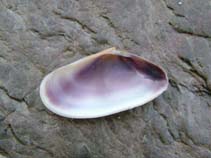Donax vittatus (da Costa, 1778)
Banded-wedge shellWarning: DOMDocument::load(): SSL operation failed with code 1. OpenSSL Error messages: error:140770FC:SSL routines:SSL23_GET_SERVER_HELLO:unknown protocol in C:\Apache24\htdocs\includes\SpeciesSummary.lib.php on line 1236
Warning: DOMDocument::load(): Failed to enable crypto in C:\Apache24\htdocs\includes\SpeciesSummary.lib.php on line 1236
Warning: DOMDocument::load(https://sealifebase.nrm.se/webservice/AquaMaps/getAMap.php?genus=Donax&species=vittatus): failed to open stream: operation failed in C:\Apache24\htdocs\includes\SpeciesSummary.lib.php on line 1236
Warning: DOMDocument::load(): I/O warning : failed to load external entity "https://sealifebase.nrm.se/webservice/AquaMaps/getAMap.php?genus=Donax&species=vittatus" in C:\Apache24\htdocs\includes\SpeciesSummary.lib.php on line 1236
Classification / Names Common names | Synonyms | CoL | ITIS | WoRMS
| Cardiida | Donacidae
Environment: milieu / climate zone / depth range / distribution range पारिस्थितिकी
; खारा; गहराई सीमा 0 - 20 m (Ref. 105964). Subtropical; 72°N - 16°N, 29°W - 37°E
वितरण देश | ऐफ ऐ ओ क्षेत्र | Ecosystems | संयोग | भूमिका
Eastern Atlantic and the Mediterranean.
Length at first maturity / आकार / वज़न / Age
Maturity: Lm ? range ? - ? cm Max length : 4.0 cm SHL पुल्लिंग / अलिंग; (Ref. 7882)
Species' maximum length, and shell height of up to 1.6 cm, from the Belgian part of the North Sea Ref. 7882). Depth based on occurrence (Ref. 2851, p. 719); to be replaced with better reference. Found in fine to muddy substrates, lying directly beneath the surface of the sea floor along the coast. Able to burrow quickly when disturbed (Ref. 7882). It is a sessile-burrower, suspension feeder (Ref. 96498). In general, suspension feeding bivalves mainly depend on phytoplankton and detritus material for nutrition (Ref. 107088).
Life cycle and mating behavior परिपक्व अवधि | पुनरुत्पत्ति | मछलीऔ का अंडे देना | अंडे | Fecundity | लार्वा
Members of the class Bivalvia are mostly gonochoric, some are protandric hermaphrodites. Life cycle: Embryos develop into free-swimming trocophore larvae, succeeded by the bivalve veliger, resembling a miniature clam.
Main reference
संदर्भ | संयोजक | सहयोगीयो
Alves, F., L. Chicharo, A. Nogueira and J. Regala. 2003. (Ref. 2851)
IUCN Red List Status (Ref. 130435)
CITES status (Ref. 108899)
Not Evaluated
CMS (Ref. 116361)
Not Evaluated
Threat to humans
Human uses
| FishSource |
साधन
अधिक जानकारी
इंटरनेट स्रोत
BHL | BOLD Systems | CISTI | DiscoverLife | FAO(Publication : search) | Fishipedia | GenBank (genome, nucleotide) | GloBI | Gomexsi | Google Books | Google Scholar | Google | PubMed | Tree of Life | Wikipedia (Go, खोज) | Zoological Record
Estimates based on models
Preferred temperature
(Ref. 115969): 9.6 - 16.1, mean 11.5 (based on 333 cells).
लौटाव
(Ref. 69278):
ऊंचा, न्यूनतम जनसंख्या दुगनी समय अवलागत 15 महीने। (K=0.61-1.32).



